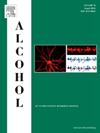操作性乙醇自我给药行为无法预测连续进入家笼饮酒的性别差异。
IF 2.9
4区 医学
Q3 PHARMACOLOGY & PHARMACY
引用次数: 0
摘要
了解疾病流行的性别差异对公共卫生至关重要,尤其是在酒精使用障碍(AUD)方面。本研究的目的是了解乙醇饮酒行为的性别差异,并确定出现性别差异的确切条件。与之前的研究结果一致,在连续获得两瓶乙醇的选择条件下,C57BL/6J雌性饮酒量高于雄性。然而,在乙醇自我给药条件下--即操作反应导致在固定时间内获得乙醇啜饮器--我们发现操作反应率或乙醇消耗量(单位体重消耗量以及舔食行为)没有性别差异。这一点在包括习得、乙醇啜饮器使用时间的调整以及乙醇浓度的调整等一系列参数中都没有改变。唯一观察到的性别差异出现在乙醇总消耗量上,其原因是雄性和雌性之间体重的差异,而不是饮酒动机的性别差异。通过降维方法,我们发现操作情境中的饮酒行为并不按性别分组,而是按高饮酒表型和低饮酒表型分组。有趣的是,这些在操作情境中的高饮酒表型和低饮酒表型与同一动物在家养笼情境中的高饮酒表型和低饮酒表型没有相关性。这些数据强调了乙醇消费中性别差异的复杂性,突出了饮酒条件/情境在这些差异表达中的重要作用。本文章由计算机程序翻译,如有差异,请以英文原文为准。
Operant ethanol self-administration behaviors do not predict sex differences in continuous access home cage drinking
Understanding sex differences in disease prevalence is critical to public health, particularly in the context of alcohol use disorder (AUD). The goal of this study was to understand sex differences in ethanol drinking behavior and define the precise conditions under which sex differences emerge. Consistent with prior work, C57BL/6J females drank more than males under continuous access two-bottle choice conditions. However, using ethanol self-administration - where an operant response results in access to an ethanol sipper for a fixed time period - we found no sex differences in operant response rates or ethanol consumption (volume per body weight consumed, as well as lick behavior). This remained true across a wide range of parameters including acquisition, when the ethanol sipper access period was manipulated, and when the concentration of the ethanol available was scaled. The only sex differences observed were in total ethanol consumption, which was explained by differences in body weight between males and females, rather than by sex differences in motivation to drink. Using dimensionality reduction approaches, we found that drinking behavior in the operant context did not cluster by sex, but rather clustered by high and low drinking phenotypes. Interestingly, these high and low drinking phenotypes in the operant context showed no correlation with those same categorizations in the home cage context within the same animals. These data underscore the complexity of sex differences in ethanol consumption, highlighting the important role that drinking conditions/context plays in the expression of these differences.
求助全文
通过发布文献求助,成功后即可免费获取论文全文。
去求助
来源期刊

Alcohol
医学-毒理学
CiteScore
4.60
自引率
4.30%
发文量
74
审稿时长
15.6 weeks
期刊介绍:
Alcohol is an international, peer-reviewed journal that is devoted to publishing multi-disciplinary biomedical research on all aspects of the actions or effects of alcohol on the nervous system or on other organ systems. Emphasis is given to studies into the causes and consequences of alcohol abuse and alcoholism, and biomedical aspects of diagnosis, etiology, treatment or prevention of alcohol-related health effects.
Intended for both research scientists and practicing clinicians, the journal publishes original research on the neurobiological, neurobehavioral, and pathophysiological processes associated with alcohol drinking, alcohol abuse, alcohol-seeking behavior, tolerance, dependence, withdrawal, protracted abstinence, and relapse. In addition, the journal reports studies on the effects alcohol on brain mechanisms of neuroplasticity over the life span, biological factors associated with adolescent alcohol abuse, pharmacotherapeutic strategies in the treatment of alcoholism, biological and biochemical markers of alcohol abuse and alcoholism, pathological effects of uncontrolled drinking, biomedical and molecular factors in the effects on liver, immune system, and other organ systems, and biomedical aspects of fetal alcohol spectrum disorder including mechanisms of damage, diagnosis and early detection, treatment, and prevention. Articles are published from all levels of biomedical inquiry, including the following: molecular and cellular studies of alcohol''s actions in vitro and in vivo; animal model studies of genetic, pharmacological, behavioral, developmental or pathophysiological aspects of alcohol; human studies of genetic, behavioral, cognitive, neuroimaging, or pathological aspects of alcohol drinking; clinical studies of diagnosis (including dual diagnosis), treatment, prevention, and epidemiology. The journal will publish 9 issues per year; the accepted abbreviation for Alcohol for bibliographic citation is Alcohol.
 求助内容:
求助内容: 应助结果提醒方式:
应助结果提醒方式:


